1994 CHEVROLET CAVALIER oil temperature
[x] Cancel search: oil temperaturePage 11 of 243
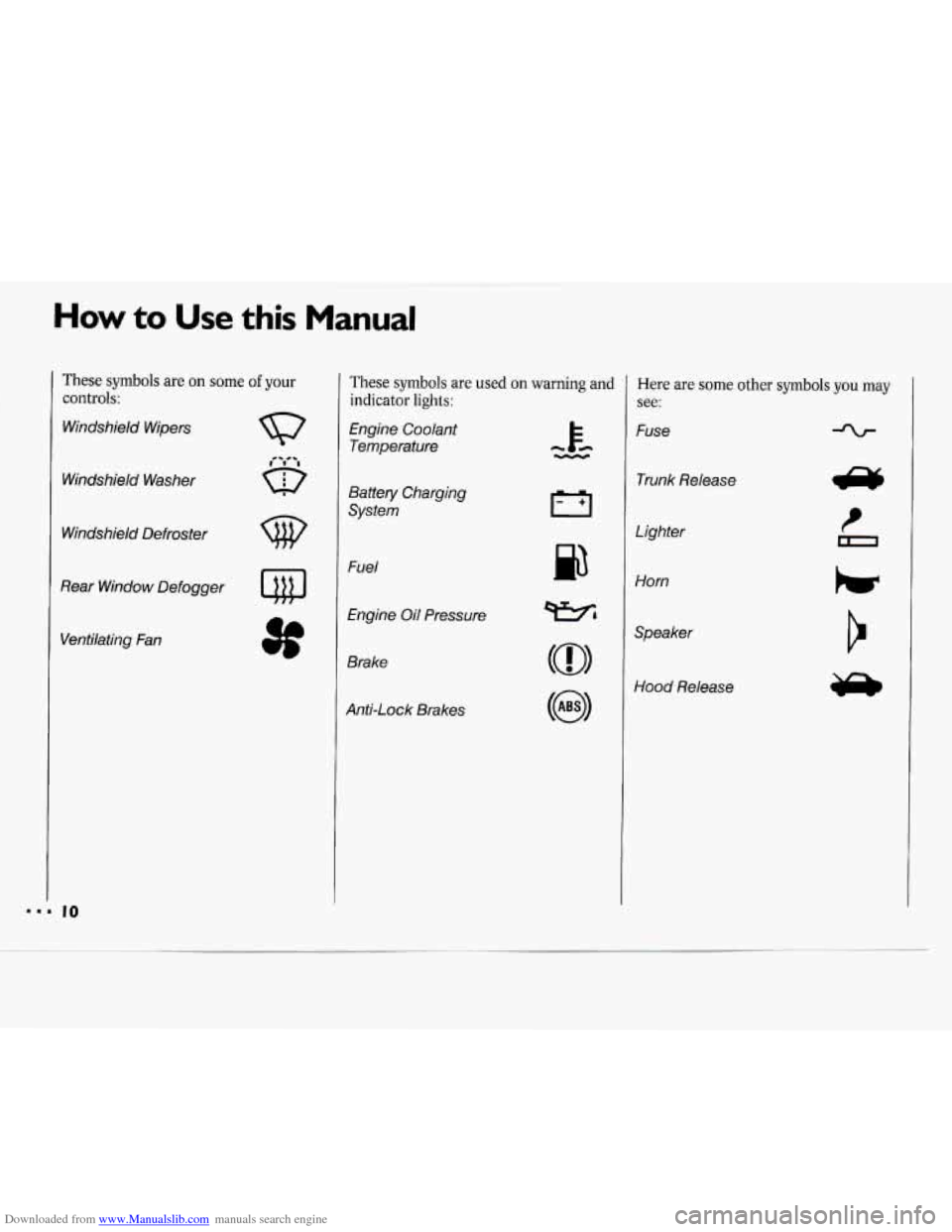
Downloaded from www.Manualslib.com manuals search engine How to Use this Manual
These symbols are on some of your
controls:
Windshield Wipers
Windshield Washer
Windshield Defroster
Rear Window Defogger
Ventilating Fan
These symbols are used on warning and
indicator
lights:
Engine Coolant
Temperature
Battery Charging
System
Fuel
Engine Oil Pressure
Brake
Anti-Lock Brakes
p3
Here are some other symbols you may
see:
Fuse
Trunk Release
Lighter
Horn
Speaker
Hood Release
Page 91 of 243

Downloaded from www.Manualslib.com manuals search engine Features & Controls
e
oil PfeSSUI'e Gage (3.7L V6 ENGINE)
The oil pressure gage shows the engine
oil presure in psi (pounds per square
inch) when the engine is running.
Canadian vehicles indicate pressure in
1tPa. Oil pressure may vary with engine
speed, outside temperature, and oil
viscosity, but readings above the red
warning zone indicate the
normal
operating range.
A reading in the red zone may be
caused by a dangerously low oil level or
other problem causing low oil pressure.
Have your vehicle serviced immediately.
NOTICE:
Damage to your engine from
neglected oil problems can be costly
and is not covered by your
warranty.
Page 164 of 243
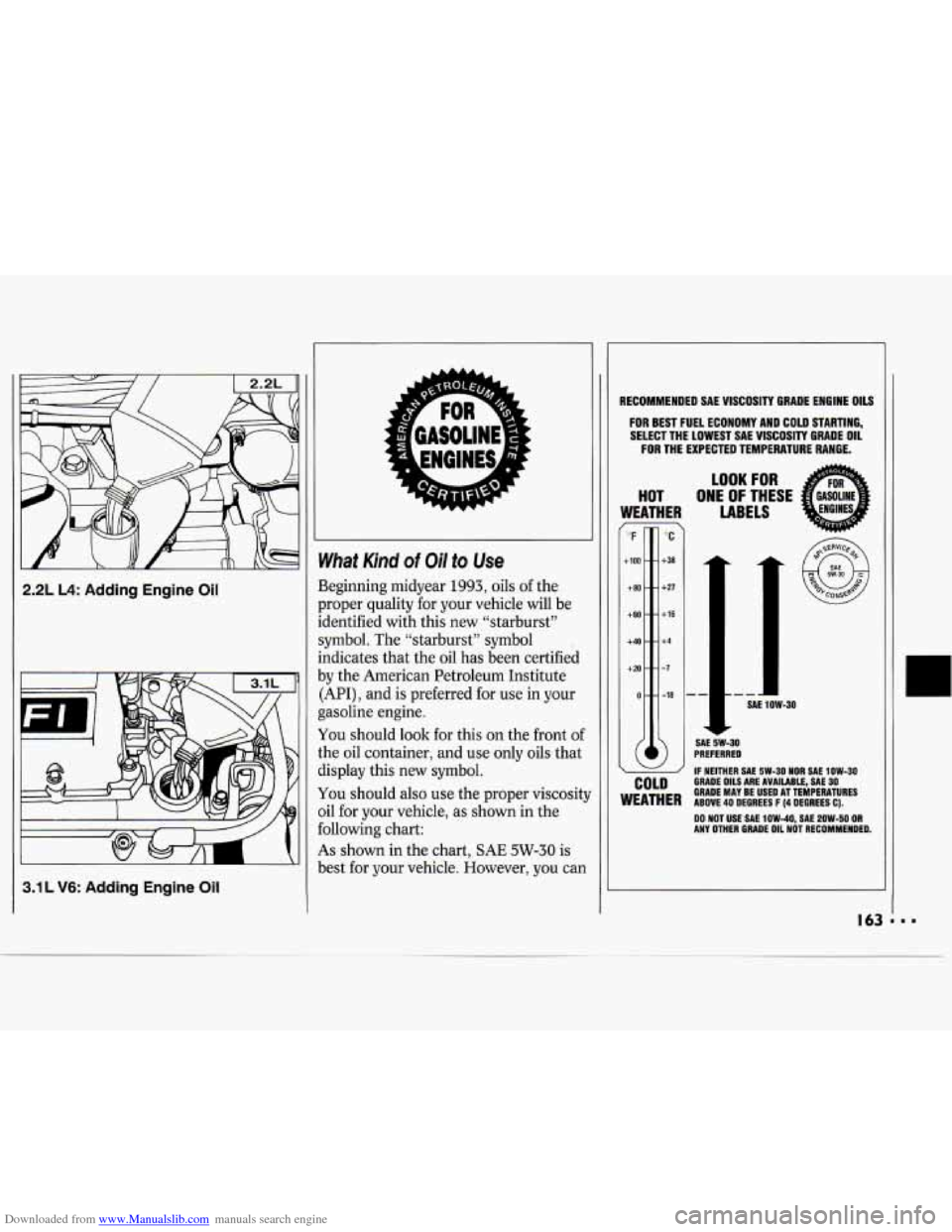
Downloaded from www.Manualslib.com manuals search engine 2.2L L4: Adding Engine Oil
3.1 L V6: Addlng Engine Oil
What Kind of Oil to Use
Beginning midyear 1993, oils of the
?roper quality for your vehicle will be
.dentified with this new “starburst”
iymbol. The “starburst” symbol
ndicates that the oil has been certified
~y the American Petroleum Institute
(API) , and is preferred for use in your
gasoline engine.
fou should
look for this on the front of
:he oil container, and use only oils that
iisplay this new symbol.
fou should also use the proper viscosit)
ail for your vehicle, as shown in the
following chart:
As shown in the chart, SAE 5W-30 is
best for your vehicle. However, you can
RECOMMENDED SAE VlSCOSlTy GRADE ENGINE OILS
FOR BEST FUEL ECONOMY AND COLD STARTING,
SELECT THE LOWEST SAE VISCOSITY GRADE
OIL
FORTHEEXPECTEDTEMPERATURERANGE.
Y
HOT
NE,
-
”F
tlOO
+ 80
+60
+40
4-20
0
’C
t38
t27
t16
t4
-1
-18
LOOK FOR
ONE OF THESE
LABELS
1
PREFERRED SAE
5W-30
IF NEITHER SAE 5W-30 NOR SAE 10W-30 COLD GRADE OILS ARE AVAILABLE, SAE 30 GRADE MAY BE USED AT TEMPERATURES WEATHER ABOVE 40 DEGREES F (4 DEGREES c).
DO NOT USE SAE 1OW-40, SAE 2OW-50 OR ANY OTHER GRADE OIL NOT RECOMMENDED.
Page 168 of 243
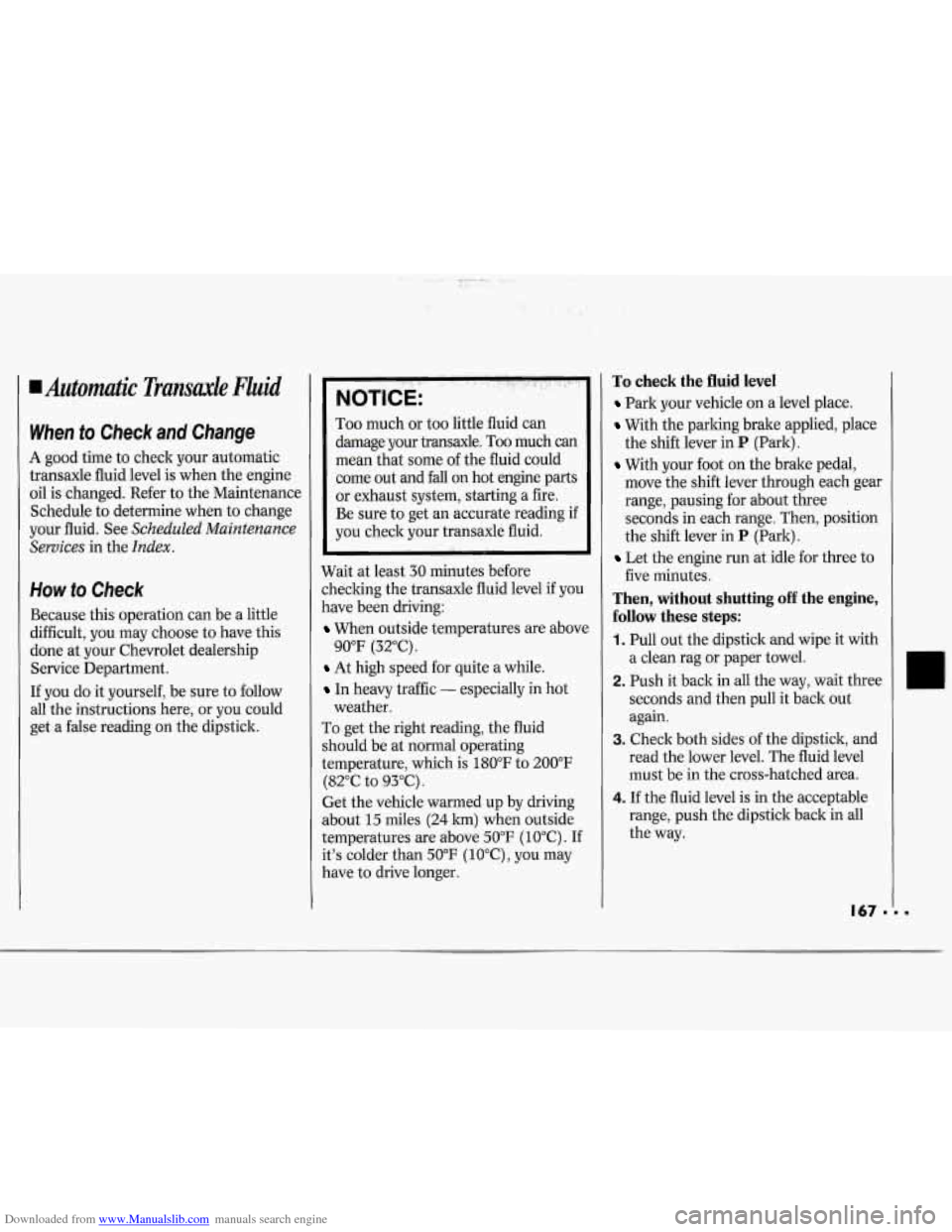
Downloaded from www.Manualslib.com manuals search engine I Automatic Transaxle Fluid
1 When to Check and Change
A good time to check your automatic
transaxle fluid level is when the engine
oil is changed. Refer to the Maintenance
Schedule to determine when to change
your fluid. See
Scheduled Maintenance
Services
in the Index.
How to Check
Because this operation can be a little
difficult, you may choose to have this
done at your Chevrolet dealership
Service Department.
If you do it yourself, be sure to follow
all the instructions here, or
you could
get a false reading on the dipstick.
NOTICE:
~. , ,'
Too much or too little fluid can
damage your transaxle.
Too much can
mean that some of the fluid could
come out and fall on hot engine parts
or exhaust system, starting a fire.
Be sure to get an accurate reading
if
you check your transaxle fluid.
Wait at least
30 minutes before
checking the transaxle fluid level
if you
have been driving:
When outside temperatures are above
At high speed for quite a while.
In heavy traffic - especially in hot
To get the right reading, the fluid
should be at normal operating
temperature, which is 180°F to 200°F
(82°C to 93°C).
Get the vehicle warmed up by driving
about 15 miles (24 lun) when outside
temperatures are above
50°F (10.C). If
it's colder than 50°F (lOOC), you may
have to drive longer.
90°F
(32°C).
weather.
To check the fluid level
Park your vehicle on a level place.
With the parking brake applied, place
With your foot on the brake pedal,
the
shift lever in
P (Park).
move the shift lever through each gear
range, pausing for about three
seconds in each range. Then, position
the shift lever in
P (Park).
Let the engine run at idle for three to
five minutes.
Then, without shutting off the engine,
follow these steps:
1. Pull out the dipstick and wipe it with
2. Push it back in all the way, wait three
a clean rag or
paper towel.
seconds and then pull it back out
again.
3. Check both sides of the dipstick, and
read the lower level. The fluid level
must be in the cross-hatched area.
4. If the fluid level is in the acceptable
range, push the dipstick back in all
the way.
Page 171 of 243
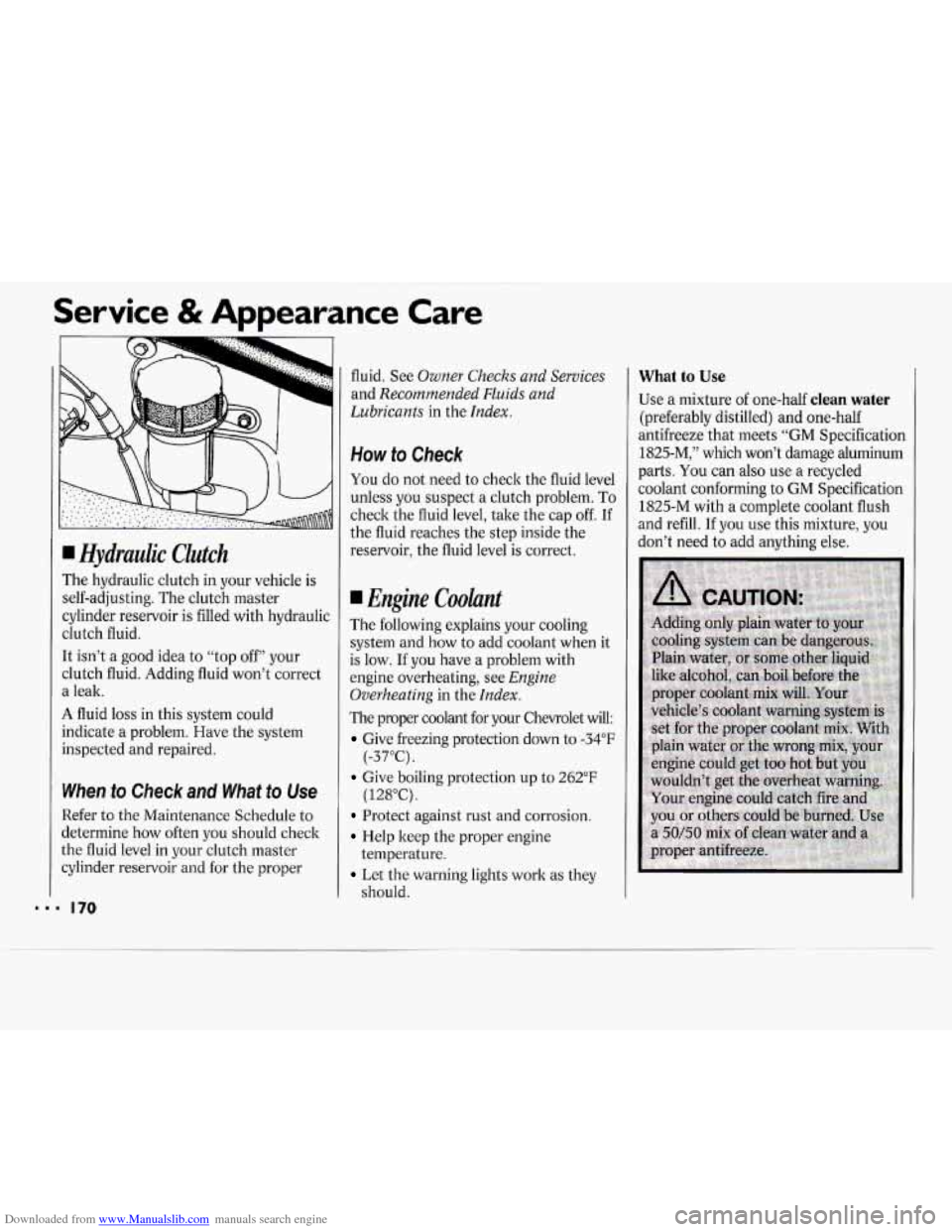
Downloaded from www.Manualslib.com manuals search engine ~~ ~ Service & Appearance Care
170
I Hydraulic Clutch
The hydraulic clutch
in your vehicle is
self-adjusting. The clutch master
cylinder reservoir is filled with hydraulic
clutch fluid.
It isn’t
a good idea to “top off” your
clutch fluid. Adding fluid won’t correct
a leak.
A fluid loss in this system could
indicate a problem. Have the system
inspected and repaired.
When to Check and What to Use
Refer to the Maintenance Schedule to
determine how often
you should check
the fluid level in your clutch master
cylinder reservoir and for the proper fluid. See
Owner Checks and
Services
and Recommended Fluids and
Lubricants
in the Index.
How to Check
You do not need to check the fluid level
unless you suspect a clutch problem.
To
check the fluid level, take the cap off. If
the fluid reaches the step inside the
reservoir, the fluid level is correct.
I Engine Coolunt
The following explains your cooling
system and how
to add coolant when it
is low.
If you have a problem with
engine overheating, see
Engine
Overheating
in the Index.
The proper coolant for your Chevrolet will:
Give freezing protection down to -34°F
Give boiling protection up to 262°F
Protect against rust and corrosion.
Help keep the proper engine
Let the warning lights work as they
(-37°C).
(128°C).
temperature.
should.
What to Use
Use a mixture
of one-half clean water
(preferably distilled) and one-half
antifreeze that meets “GM Specification
1825-M,” which won’t damage aluminum
parts. You can also use a recycled
coolant conforming to GM Specification
1825-M with
a complete coolant flush
and refill. If you use this mixture, you
don’t need to add anything else.
Page 203 of 243

Downloaded from www.Manualslib.com manuals search engine Service & Appearance Care
I..
Engine Specifications
VIN Engine Code .....................................................................
Type ........................................................................\
..................
Displacement ........................................................................\
...
Compression Ratio ... .. ... , . ....... .. .. ........ ... . .. . ... .... ......... ........ . . . . .. .
Firing Order ........................................................................\
.....
Thermostat Temperature .........................................................
Normal Maintenance Replacement Parts
Air Cleaner Element
2.2L L4 ........................................................................\
............. AC Type A-1172C
3.1L V6
........................................................................\
........... AC Type A-1098C
2-24
........................................................................\
............. AC Type A-925C
Engine Oil Filter
2.2L L4 ........................................................................\
............ AC Type PF-47
3.1L V6
....................... , ..................... .... .... ......... .. ..... ... . .. .. .. .. . . AC Type PF-47
2.2L L4
........................................................................\
............ AC Type CV-9OOC
3.1L V6 ........................................................................\
........... AC Type CV-892C
2.2L L4
........................................................................\
............ AC Type 041-908
3.1L V6
........................................................................\
........... AC Type R44LTSM
PCV Valve
Spark Plugs
Gap: 1.52 mm (0.060 inch)
Gap: 1.14 mm
(0.045 inch)
2.2L L4
4
14
2.2 Liters
8.85: 1
1-3-4-2
195°F (91°C)
3.1L V6
T
V6
3.1 Liters
8.80: 1
1-2-3-4-5-6
195°F (91OC)
1 202
Page 207 of 243
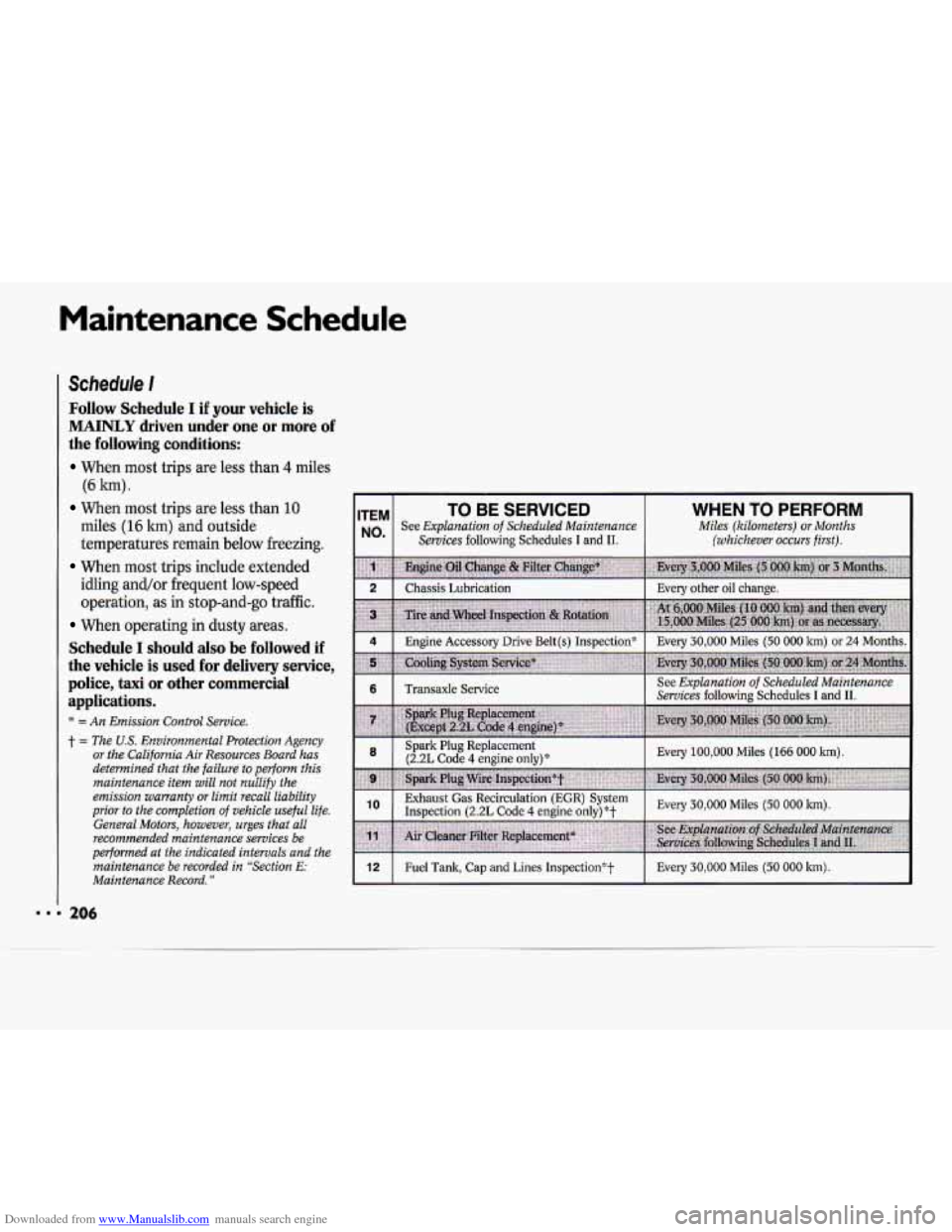
Downloaded from www.Manualslib.com manuals search engine Maintenance Schedule
Schedule I
Follow Schedule I if your vehicle is
MAINLY driven under one or more of
the following conditions:
When most trips are less than 4 miles
When most trips are less than 10
(6
km).
miles
(16 ltm) and outside
temperatures remain below freezing.
When most trips include extended
idling and/or frequent low-speed
operation, as in stop-and-go traffic.
When operating in dusty areas.
Schedule I should also be followed if
the vehicle is used for delivery service,
police, taxi
or other commercial
applications.
* = An Emission Control Service.
t = The US. Environmental Protection Agency
or the California Air Resources Board has
determined that the failure to perform this
maintenance item
will not nullify the
emission warranty
or limit recall liability
prior to the completion
of vehicle useful life.
General Motors, however, urges that all
recommended maintenance services be
performed at the indicated intervals and the maintenance be recorded in “Section
E:
Maintenance Record. ”
ITEM
Services following Schedules I and 11. Nom
TO BE SERVICED
See Explanation of Scheduled Maintenance
WHEN TO PERFORM
Miles (kilometers) or Months
(whichever occurs first).
I 2 I Chassis Lubrication I Every other oil change. I
I 4 I Engine Accessory Drive Belt(s) Inspection* I Every 30,000 Miles (50 000 km) or 24 Months. I
Page 211 of 243
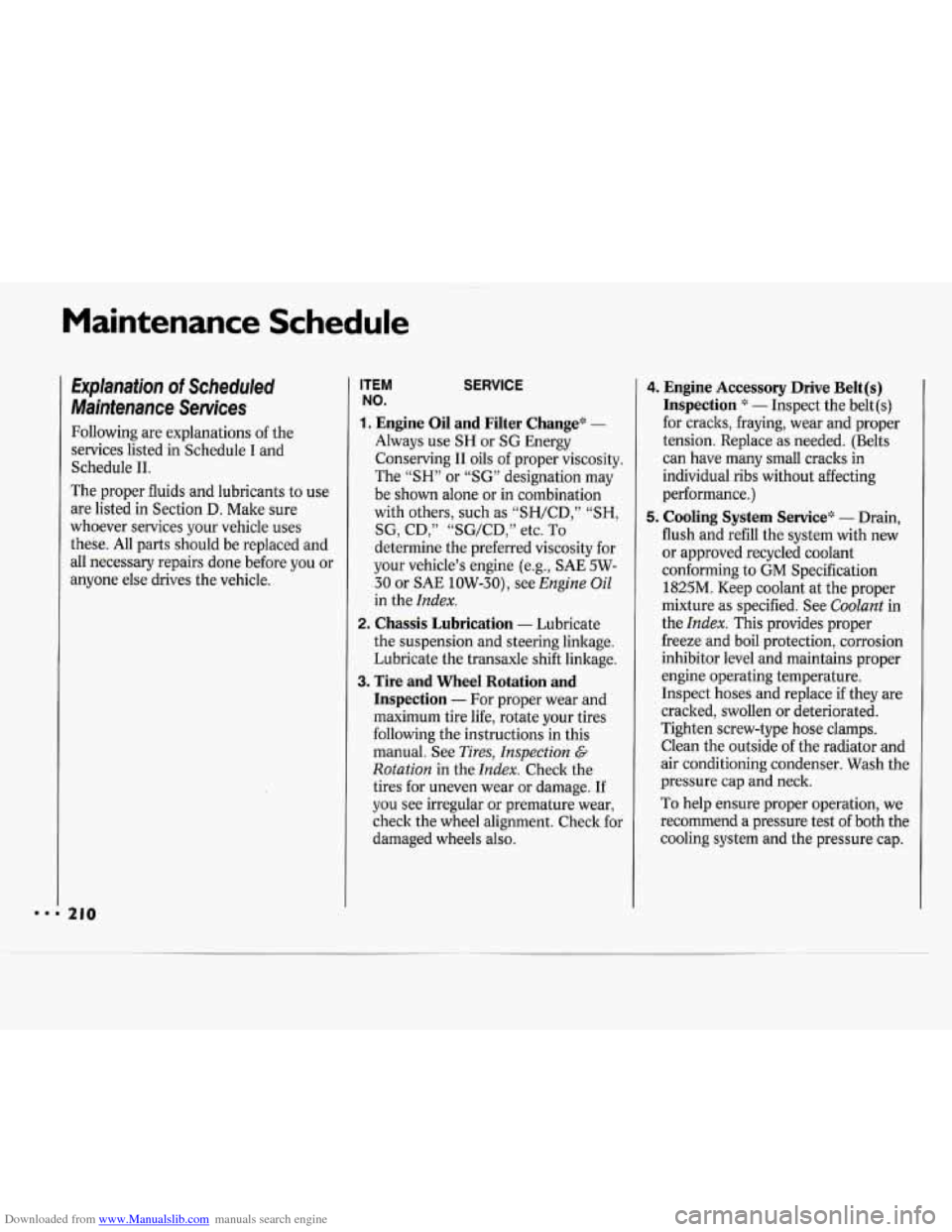
Downloaded from www.Manualslib.com manuals search engine Maintenance Schedule
Explanation of Scheduled
Maintenance Services
Following are explanations of the
services listed in Schedule
I and
Schedule 11.
The proper fluids and lubricants to use
are listed in Section
D. Make sure
whoever services your vehicle uses
these. All parts should be replaced and
all necessary repairs done before you or
anyone else drives the vehicle.
ITEM SERVICE
NO.
1. Engine Oil and Filter Change* -
Always use SH or SG Energy
Conserving I1 oils of proper viscosity.
The
“SH” or “SG” designation may
be shown alone or in combination
with others, such as “SH/CD,”
“SH,
SG, CD,” “SG/CD,” etc. To
determine the preferred viscosity for
your vehicle’s engine (e.g., SAE 5W-
30 or SAE 10W-30), see
Engine Oil
in the Index.
the suspension and steering linkage.
Lubricate the transaxle shift linkage.
Inspection - For proper wear and
maximum tire life, rotate your tires
following the instructions in this
manual. See
Tires, Inspection G
Rotation in the Index. Check the
tires for uneven wear or damage. If
you see irregular or premature wear,
check the wheel alignment. Check for
damaged wheels also.
2. Chassis Lubrication - Lubricate
3. Tire and Wheel Rotation and
4. Engine Accessory Drive Belt(s)
Inspection
* - Inspect the belt (s)
for cracks, fraying, wear and proper
tension. Replace as needed. (Belts
can have many small cracks in
individual ribs without affecting
performance.)
5. Cooling System Service* - Drain,
flush and refill the system with new
or approved recycled coolant
conforming to
GM Specification
1825M. Keep coolant at the proper
mixture as specified. See
Coolant in
the
Index. This provides proper
freeze and boil protection, corrosion
inhibitor level and maintains proper
engine operating temperature.
Inspect hoses and replace if they are
cracked, swollen or deteriorated.
Tighten screw-type hose clamps.
Clean the outside of the radiator and
air conditioning condenser. Wash the
pressure cap and neck.
To help ensure proper operation, we
recommend a pressure test
of both the
cooling system and the pressure cap.